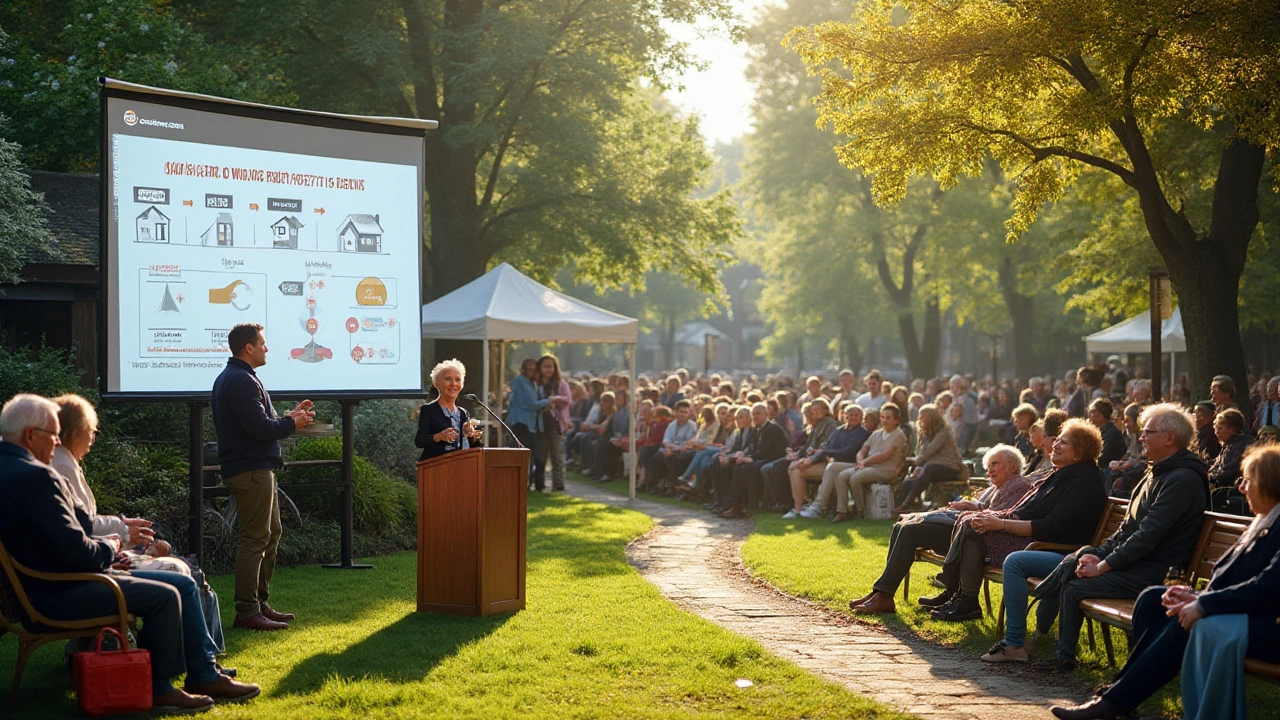Understanding Shared Ownership Homes: Shares of Ownership Explained
 Oct, 17 2024
Oct, 17 2024
Imagine wanting to own a home but finding the traditional paths closed, perhaps due to soaring prices or limited financial options. Shared ownership might just be the key you didn't know you had. This unique system works by letting you buy a slice of a property while renting the rest. It offers an intriguing mix of freedom and responsibility unlike traditional home buying or renting. Understanding this setup can be your ticket to securing a place you've long dreamed of calling your own.
Shared ownership schemes mean you don't have to choose between renting forever or saving endlessly for a full property purchase. Instead, you get a chance to invest in the housing market bit by bit. Yet, it's not as simple as snapping your fingers and becoming a co-owner. Every twist in this method needs careful thought, especially since it blends aspects of owning and renting. So, how do you effectively tread this curious path to home ownership?
- What is Shared Ownership?
- How Shares of Ownership Work
- Pros and Cons of Shared Ownership
- Financial Considerations
- Making the Right Decision
What is Shared Ownership?
Shared ownership is an innovative housing solution designed to make homeownership more accessible, particularly for first-time buyers and those with modest incomes. With this arrangement, individuals purchase a shared ownership stake in a property—typically between 25% and 75%—while paying rent on the remaining share to a housing association or a government agency. The beauty of this model is that it allows people to enter the housing market at a price point that is more manageable than buying outright, bridging the gap between renting and full ownership. It offers a middle ground where monthly outgoings can often be lower than a traditional mortgage or paying rent on an entire home.
The concept of shared ownership dates back several decades, finding its roots in various government initiatives aimed at tackling housing affordability. The model has evolved, gaining popularity in regions where housing prices have skyrocketed, leaving potential homeowners without viable purchasing options. This approach has not only opened doors for those locked out of the market but also provided a stable housing solution that fosters community involvement and neighborhood stability. By owning a stake in the property, individuals feel a greater sense of belonging and responsibility, contributing to both economic and social benefits.
In the real estate landscape, shared ownership homes can often be found in newly developed areas, which are part of broader urban renewal or regeneration projects. Developers and local governments coordinate to offer these homes as part of strategic plans to cultivate diverse and economically balanced communities. A fascinating aspect of shared ownership is the option to 'staircase,' which means homeowners can purchase additional shares in the property over time, eventually allowing them to own the property outright if desired. This flexibility is one of the key reasons why shared ownership remains an attractive option.
“Shared ownership provides an opportunity for those who find themselves priced out of full homeownership, offering a flexible path to increase their stake,” says a housing market analyst.As more people explore this model, shared ownership adapts to meet new demands, integrating modern features into its framework, such as eco-friendly designs and technology-enabled homes. This evolution ensures shared ownership stays aligned with market trends, offering valuable options for those seeking a pathway to owning their home. It’s a dynamic, community-focused solution secured with backing from both governmental and private sectors, promising a secure investment for aspiring homeowners.
How Shares of Ownership Work
Diving into the world of shared ownership might feel like stepping into a new realm of home buying, but it's essentially about compromise and balance. It all starts with purchasing a share of a property, typically ranging anywhere from 25% to 75%. This percentage determines your ownership stake and the amount you'll pay in connection to owning it. While the idea of owning even part of a home is enticing, it's essential to know that you only finance and have mortgage repayments on the share you buy. The remainder is essentially rented from a housing association or similar entity, which bridges the gap between full ownership and tenancy.
The monthly housing costs blend both mortgage payments and rent. You pay off your loan in proportion to your ownership percentage, while the rent covers the remaining share you do not own. Interestingly enough, rent is usually charged at a reduced rate, making shared ownership a viable option for those priced out of the conventional market. As time passes, there's often a chance to buy more shares, increasing your ownership stake through a process called staircasing. This option lets you gradually own the property outright, potentially resulting in significant financial gains if property values increase. A flexibility to boost ownership without a drastic financial leap is what makes this arrangement attractive to many aspiring homeowners.
Becoming a shared owner also obliges you to adhere to specific terms concerning home maintenance and modifications. You need to think about it—they often require permission from the housing association for significant changes, preserving the structure and value of the property, which can add another layer to decision-making. But here's the thing—not all properties are eligible, usually preferring new builds and select pre-owned homes that comply with government or local schemes designed to assist low to middle-income earners.
Interestingly, these initiatives are far more popular in larger urban centers where property costs remain high. Take the UK, for instance, where shared ownership has been a key part of the government’s strategy to make housing affordable. According to a report by the UK Government, shared ownership homes accounted for an estimated 1.1% of all homes in the region. Historical figures also suggest that demand is on a steady rise as individuals continue to search for more affordable ways to step onto the property ladder.

Pros and Cons of Shared Ownership
Navigating the world of shared ownership homes comes with its own set of unique advantages and challenges. On the bright side, this model opens doors for many potential homeowners who might otherwise be locked out of traditional property markets due to financial constraints. The prospect of purchasing a portion of the property, typically between 25% to 75%, while still paying rent on the remainder can be an attractive stepping stone, providing the stability of home ownership without the initial hefty costs of buying a full property outright. This approach often requires a smaller deposit compared to buying a house on the open market, which can be a significant relief. This situation can certainly favor those looking to dip their toes into real estate investment without plunging headfirst.
Homes within a shared ownership scheme are typically overseen by a housing association or similar body, providing a degree of reassurance over maintenance and management. That can ease some of the burdens traditionally associated with property management. Being part of such a scheme can also mean access to a community where help and resources could be readily available. Moreover, shared ownership can serve as a stable middle ground for those who may have fluctuating incomes, allowing for a more affordable path to eventual full ownership through a process known as 'staircasing', where buyers can gradually purchase more shares until they own the property outright.
"Shared ownership offers a valuable foothold onto the property ladder, creating opportunities for those who might otherwise face exclusion," remarks a real estate analyst from the UK Housing Federation.
However, even the enticing world of real estate opportunities isn't without its drawbacks. Critics of shared ownership highlight potential pitfalls including the potentially high cost of rent on the remaining share of the property. Depending on the contract, owners might face restrictions on the freedom to customize their homes or even on subletting to others, which is something important to consider. Additionally, selling a shared ownership home can sometimes be more complicated than a traditional property sale. The housing association usually has the right to find a buyer for your share if you choose to sell, which could limit the open market exposure of your property and potentially impact the selling price.
It’s essential to remember that while you gain equity in the property, shared ownership homes are still leasehold properties, meaning you don't own the land the property sits on. Understanding the terms and conditions of the lease is crucial for avoiding any unpleasant surprises down the road. The cost of staircasing also needs to be factored in; as you buy more shares, you may face additional valuation and legal fees. Awareness of these nuances is key to making informed decisions in the path of shared ownership.
| Pros | Cons |
|---|---|
| Lower deposit requirement | Potentially high rent |
| Gradual acquisition | Limited control and restrictions |
| Community support | Complex resale process |
| Stability against fluctuations | Additional costs for staircasing |
Financial Considerations
When you start exploring shared ownership homes, it's crucial to get a deep understanding of the financial landscape you're about to enter. This approach to home buying can be simpler and more accessible than the traditional route, but it has its own set of unique considerations. The first aspect to tackle is the initial investment. Unlike conventional mortgages where a hefty deposit is the norm, shared ownership requires a smaller deposit since you're only buying a portion of the property. For many, this lower barrier to entry is the main attraction of shared ownership.
Yet, the financial commitment doesn't stop with the deposit. Shared ownership involves both buying and renting, meaning you'll have to budget carefully for both mortgage repayments on your share and monthly rent payments on the remaining portion. Keep in mind that the rent you pay is typically lower than market rent, often around 2.75% of the property's value. Getting a grip on your total monthly outgoings is essential to ensure you can comfortably afford both elements over time.
Another financial angle to ponder is the viability of staircasing, a process that allows you to incrementally purchase more shares of your home until, potentially, you own it outright. While this may seem like an exciting prospect, each increase in ownership share comes with its own costs, such as reassessment fees, legal fees, and potentially higher mortgage payments. You'll want to evaluate your financial readiness and long-term goals before embarking on this journey.
Furthermore, it is vital to understand how shared ownership impacts the resale value of your home. While you theoretically share in any appreciation of the property's value, the resale process involves specific terms and conditions that could affect the price you can command. Another point to note is the likelihood of additional fees tied to the resale process, such as valuation fees and marketing costs suggested by your housing association.
To navigate these complexities, consulting financial advisors or real estate experts can be invaluable. According to the UK Government's guidance on shared ownership, "Engaging with advisors who have experience in shared ownership can help clarify potential costs and financial benefits." Their insight will aid you in crafting a comprehensive budget and understanding the potential return on your investment.
Lastly, it's worth addressing potential changes in your financial situation. The flexibility of shared ownership can support you through life's shifts, such as changes in income or family needs, but it's crucial to approach it with a clear financial plan. Forecasting various scenarios alongside your advisor can aid in cushioning any unexpected shifts. By planning thoroughly, you ensure that your venture into shared ownership becomes a wise, sustainable choice driven by informed decision-making.

Making the Right Decision
Choosing shared ownership can seem like a leap into the unknown, but it doesn't have to be that way. This decision should be grounded in a deep understanding of both your financial landscape and personal life goals. Before anything else, reflect on why you are considering this path. Is it because you're eager to join the property market but find the upfront costs of a full purchase overwhelming? Or perhaps, you're attracted by the flexibility that owning a portion of the property brings.
Timeframes are essential in this regard. Consider how long you plan to live in the property. If your aim is short-term, the costs associated with selling your share might not align with your financial goals. On the other hand, if you envision settling for years or potentially staircasing – the process of increasing your ownership share over time – the long-term benefits could be favorable. According to the UK Housing Portal, "staircasing allows homeowners to become full owners incrementally, easing the financial burden at each step."
Financial projection is another factor worthy of your attention. Take a thorough look at property prices in the intended neighborhood compared to current and expected rental rates. This comparison can offer a straightforward insight into whether shared ownership results in meaningful economic value over time. Evaluate associated costs through a budget plan that covers not just the rent and mortgage, but service charges, maintenance, and potential repair expenses. Being unprepared for these often-neglected elements can lead to financial discomfort.
Legal details should not be overlooked. The agreements in shared ownership can be intricate, with clauses on resale and maintenance responsibilities needing particular attention. It might be a wise move to talk with a financial advisor or solicitor familiar with the nuances of shared ownership agreements who can guide you through. Exploring resources, such as government websites or trusted real estate forums, can provide a wealth of insights and community experiences that illuminate your path forward.
To take a well-rounded decision, it's valuable to tap into personal anecdotes or reviews from those who've walked this path before. These stories can elucidate not just the mechanics but also the emotional journey involved. An informed choice shouldn't be solely data-driven but also empathetic to lifestyle aspirations. It's about finding a place that resonates not only with your budget but with your heart.
Ultimately, the decision about shared ownership demands a careful trifecta of introspection, calculation, and consultation. By aligning financial insights with personal dreams and seeking advice from knowledgeable figures, you'll place yourself on solid ground. The rhythm of home ownership, though different through this path, can still march to the beat of your own choosing, as your stake grows with each new opportunity.